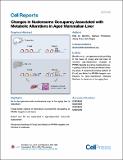Changes in Nucleosome Occupancy Associated with Metabolic Alterations in Aged Mammalian Liver
Author(s)
Bochkis, Irina M.; Przybylski, Dariusz; Chen, Jennifer; Regev, Aviv
DownloadRegev_Changes in.pdf (3.088Mb)
PUBLISHER_CC
Publisher with Creative Commons License
Creative Commons Attribution
Terms of use
Metadata
Show full item recordAbstract
Aging is accompanied by physiological impairments, which, in insulin-responsive tissues, including the liver, predispose individuals to metabolic disease. However, the molecular mechanisms underlying these changes remain largely unknown. Here, we analyze genome-wide profiles of RNA and chromatin organization in the liver of young (3 months) and old (21 months) mice. Transcriptional changes suggest that derepression of the nuclear receptors PPARα, PPARγ, and LXRα in aged mouse liver leads to activation of targets regulating lipid synthesis and storage, whereas age-dependent changes in nucleosome occupancy are associated with binding sites for both known regulators (forkhead factors and nuclear receptors) and candidates associated with nuclear lamina (Hdac3 and Srf) implicated to govern metabolic function of aging liver. Winged-helix transcription factor Foxa2 and nuclear receptor corepressor Hdac3 exhibit a reciprocal binding pattern at PPARα targets contributing to gene expression changes that lead to steatosis in aged liver.
Date issued
2014-11Department
Harvard University--MIT Division of Health Sciences and Technology; Massachusetts Institute of Technology. Department of BiologyJournal
Cell Reports
Publisher
Elsevier B.V.
Citation
Bochkis, Irina M., Dariusz Przybylski, Jenny Chen, and Aviv Regev. “Changes in Nucleosome Occupancy Associated with Metabolic Alterations in Aged Mammalian Liver.” Cell Reports 9, no. 3 (November 2014): 996–1006.
Version: Final published version
ISSN
22111247